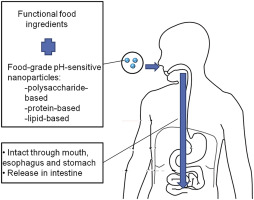Trends in Food Science & Technology ( IF 15.1 ) Pub Date : 2019-12-23 , DOI: 10.1016/j.tifs.2019.12.019 Ke Xiong , Liyang Zhou , Jinyu Wang , Aiguo Ma , Di Fang , Liu Xiong , Qingjie Sun

|
Background
Functional food ingredients can improve human health. However, the bioavailability of many functional food ingredients after oral administration is low because of their instability in the human gastrointestinal tract and low solubility in water. Food-grade pH-sensitive nanoparticles can efficiently deliver functional food ingredients into the human intestine, improve their solubility, and enhance absorption through enteric epithelial cells. In addition, these nanoparticles are biocompatible and non-toxic. Thus, food-grade pH-sensitive nanoparticles are promising carriers for delivering functional food ingredients.
Scope and approach
This review first introduces a few important functional food ingredients, their benefits for human health, and challenges regarding human intake. Then the existing food-grade pH-sensitive nanoparticles from the literature are categorized into three groups for review: polysaccharide-based, protein-based and lipid-based pH-sensitive nanoparticles. Examples are provided to illustrate the preparation methods and working principles of food-grade pH-sensitive nanoparticles.
Key findings and conclusions
Food-grade pH-sensitive nanoparticles can increase the bioavailability of functional food ingredients by improving their stability in the human stomach and by controlling their release into the intestine. Further investigations are needed to examine the effects of other factors in the human gastrointestinal tract (e.g. ions and digestive enzymes) on the stability of food-grade pH-sensitive nanoparticles. The non-toxicity of food-grade pH-sensitive nanoparticles needs to be confirmed. Combinations of in vivo and in vitro experiments could provide helpful information that would accelerate the commercialization of food-grade pH-sensitive nanoparticles.
中文翻译:

食品级pH敏感纳米颗粒的构建,用于输送功能性食品成分
背景
功能性食品成分可以改善人体健康。但是,许多功能性食品成分在口服后的生物利用度低,这是因为它们在人的胃肠道中不稳定并且在水中的溶解度低。食品级pH敏感纳米颗粒可以有效地将功能性食品成分输送到人体肠道,提高其溶解度,并增强通过肠上皮细胞的吸收。另外,这些纳米颗粒是生物相容的并且是无毒的。因此,食品级pH敏感纳米颗粒是用于输送功能性食品成分的有希望的载体。
范围和方法
这篇评论首先介绍了一些重要的功能性食品成分,它们对人体健康的益处以及人体摄入方面的挑战。然后将文献中现有的食品级pH敏感纳米颗粒分为三类:基于多糖,基于蛋白质和基于脂质的pH敏感纳米颗粒。提供实例说明食品级pH敏感纳米颗粒的制备方法和工作原理。
主要发现和结论
食品级pH敏感纳米颗粒可通过改善功能性食品成分在人胃中的稳定性并控制其在肠道中的释放来提高其生物利用度。需要进一步的研究来检查人胃肠道中其他因素(例如离子和消化酶)对食品级pH敏感纳米颗粒稳定性的影响。食品级pH敏感纳米颗粒的无毒性需要得到证实。体内和体外实验的结合可以提供有用的信息,这些信息将加速食品级pH敏感纳米颗粒的商业化。









































 京公网安备 11010802027423号
京公网安备 11010802027423号